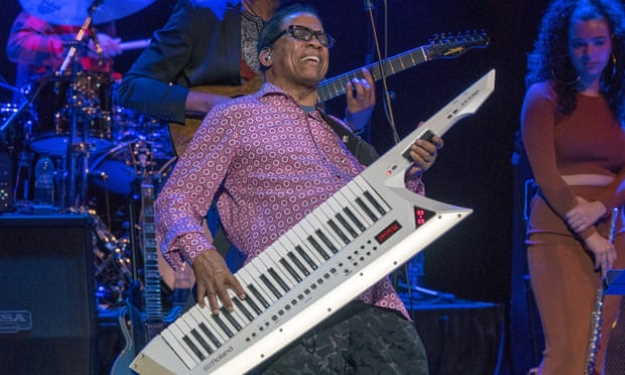|
Taken from The Guardian (Nov 18, 2019)
Herbie Hancock review - fusion fantasist digs deep to keep it fresh
London Jazz festival, Barbican
Even after half a century, the jazz legend's playing was unpredictable as he switched effortlessly between styles
4/5 stars
by Ammar Kalia

Crowd-pleaser ... Herbie Hancock performing at the Barbican as part of the London Jazz festival.
Photograph: Richard Gray/EMPICS Entertainment |
There is a well-known photograph of Herbie Hancock aged 23, when he had just joined the Miles Davis Quintet. Taken by Blue Note label co-founder Francis Wolff, it shows Hancock in black and white, fresh-faced, sleeves rolled to the elbow and sitting at the piano. One hand is delicately placed on the keys in waiting, while his head is turned over his shoulder looking expectantly for direction. His face tilts into a shaft of light and his skin radiates its glow back to us in its youthful, untroubled smoothness.
Here in 1963, Hancock was already recording his third studio album, Inventions & Dimensions, a Latin-fuelled departure from the modal sound that saw the young pianist labelled a prodigy. In his ensuing 56-year career, Hancock has lost none of the calm, learned focus that marks out that early photograph. With his headline performance at London Jazz festival, he continues in the tradition of bringing up younger musicians - as Davis did with him - now featuring 24-year-old flautist Elena Pinderhughes.
If there is one thing that marks out Hancock's musical style, it is the genre-eating openness of it, fingering through balladic Bill Evans lines to Joni Mitchell-inspired introspection, George Clinton synth-funk and then back to a hard swing in one passage. This makes the Hancock live experience unpredictable and sometimes frustrating. With Hancock sitting amid his grand piano, synthesisers and keytar, the music changes direction seemingly at will.
Opening with a cascading flurry of synths, Hancock switches into an air-tight groove with guitarist Lionel Loueke, both playing percussively, before revealing glimpses of the melody to Butterfly above drummer Justin Tyson's screaming fills. Longtime Hancock bassist James Genus provides a consistent metronomic grounding no matter how slippery Hancock's changes get, while Pinderhughes glides through a kaleidoscope of chromatics in her solo breaks. The packed crowd nods along faithfully.
Hancock's ultimate strength comes from his sponge-like capacity to absorb the playing styles of his band members into his renditions. Where he was last in London playing with hip-hop producer Terrace Martin to create a swaggering post-bop fusion, here he hits hard and heavy with open-voiced chords, mirroring Tyson's gospel chops on his Headhunters classic Actual Proof, while softening into a vocoder ballad with Pinderhughes' honeyed singing on Come Running to Me. Crucially, Hancock gives his band ample space to play, with Genus delivering a beautifully looped harmonic solo and Loueke his signature vocal polyphony during the two-hour set.
Bringing out his keytar and pottering around the stage like a kindly patriarch for crowd-pleasers Cantaloupe Island and Chameleon, Hancock shows that it is possible to play the same songs for over 40 years and still find meaning within the notes, stretching and bending them into new shapes. And therein lies the special appeal of his music: the capacity to always dig deep to find the differing narratives produced by those 88 keys. It is a gentle yet persistent questioning, one heralded by that expectant gaze in 1963 and one that still glints through his glasses now, anticipating the next generation of players sitting with him.
The London jazz festival continues until 24 November.
|